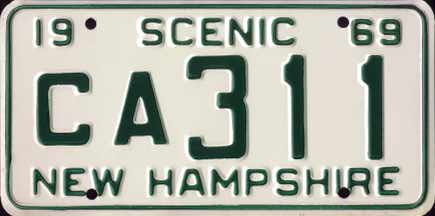
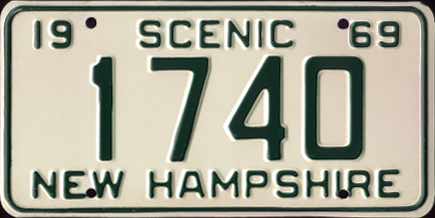
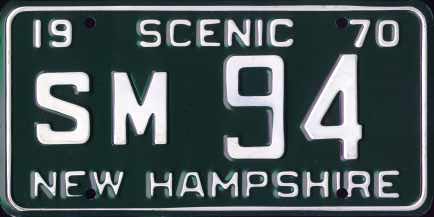
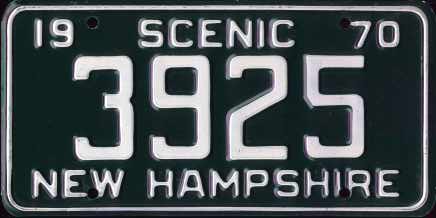

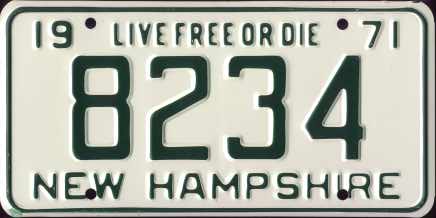

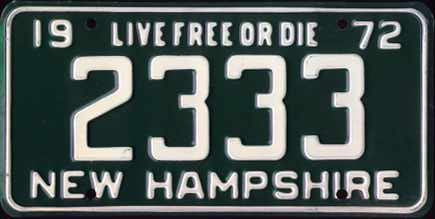
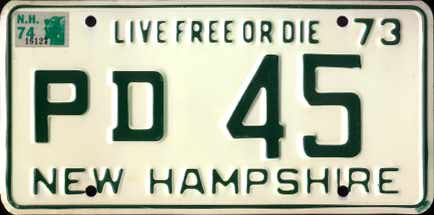
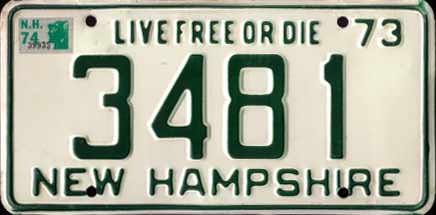
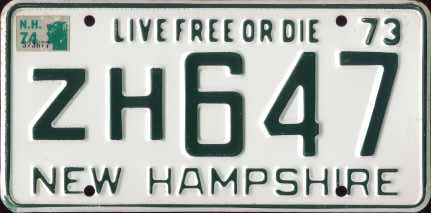
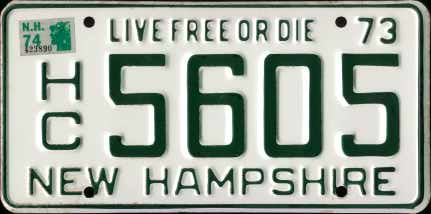
![NH 74 #[KKB]0030](us3/nh74d.jpg)
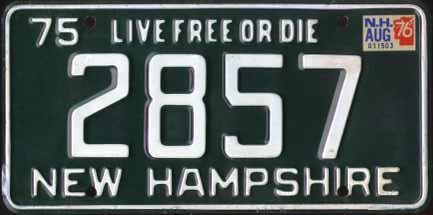
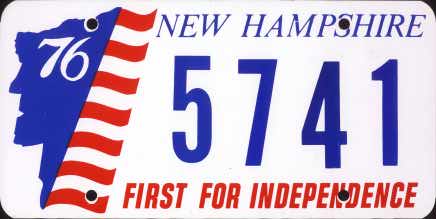
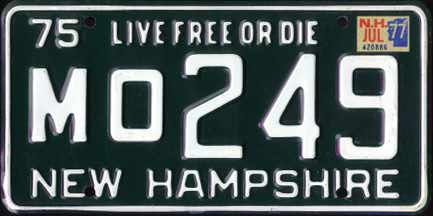
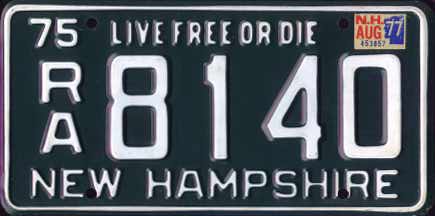
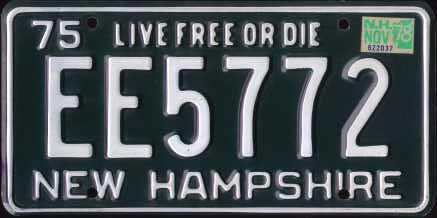
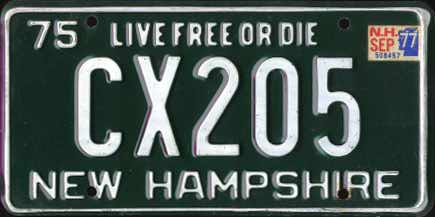
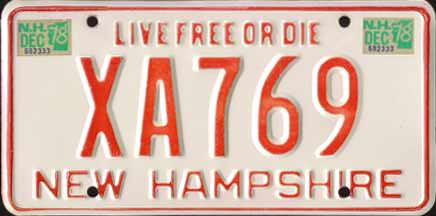
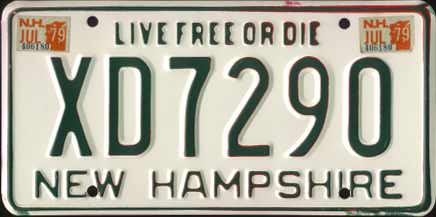
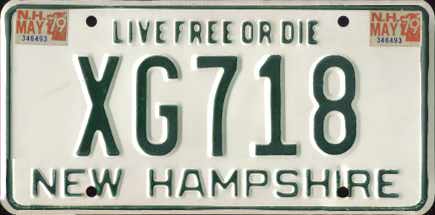
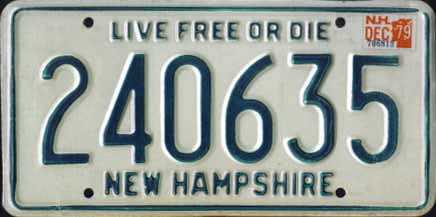
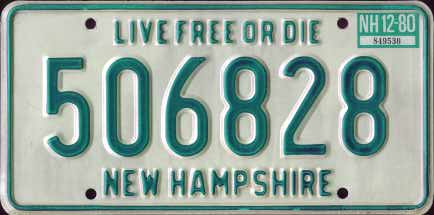
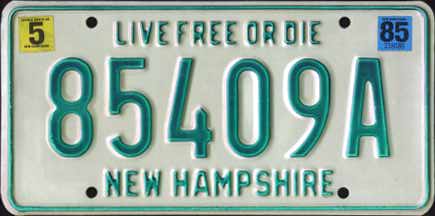
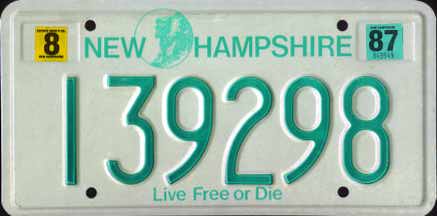
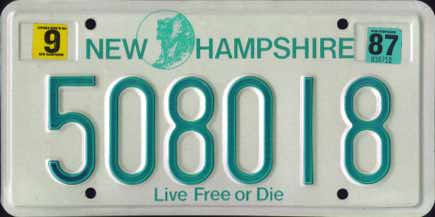
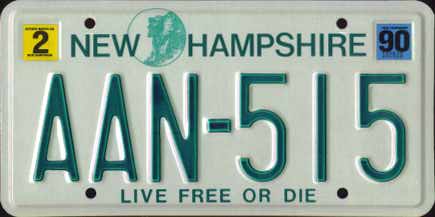
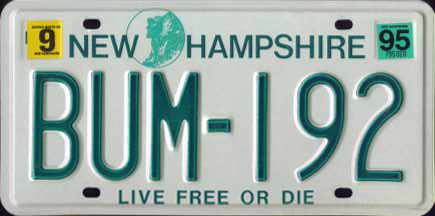

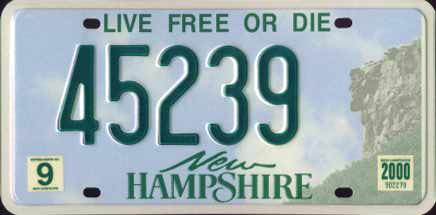
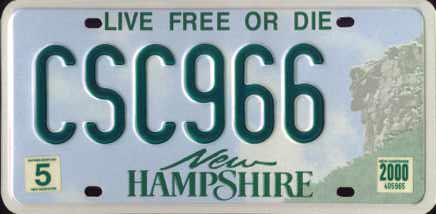
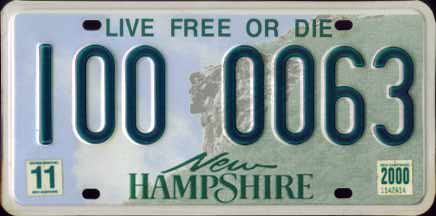
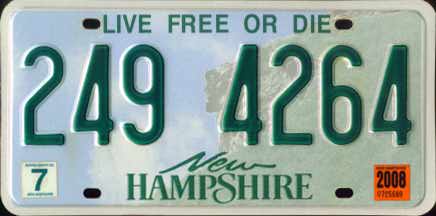

 |
New Hampshire 1969 passenger issue. New Hampshire plates had been rotating between green-on-white and white-on-green since 1914. This plate carries the "Scenic" slogan, first appearing in 1957. This is the standard format plate with a two-letter county code and 1-3 numbers. Plates beginning with C were issued in Carroll county. Click here for a complete listing of New Hampshire county codes. |
 |
New Hampshire 1969 passenger issue. Issues containing 1-4 numbers and no county coding were also issued during this period. In most cases, these numbers carried over to the same owner from year to year. |
 |
New Hampshire 1970 passenger issues. As usual, colors reversed to white on green. Plates starting with S were issued in Sullivan county, and again, plates numbered from 1-9999 were issued during this period without county coding. This was the last year of the "Scenic" slogan for New Hampshire. |
 | |
 |
New Hampshire 1971 passenger issues. This was the first general issue to carry the controversial "Live Free or Die" slogan (it was actually introduced on 1970 vanity issues). This slogan proved controversial, with the United States Supreme Court hearing a case in 1977 (Wooley v. Maynard) brought by a family of Jehovah's Witnesses, one of whom had actually served jail time for refusing to pay fines related to covering up the slogan on the family vehicle's plates. The Court ruled that the state had the right to use the slogan, but that it could not prosecute motorists who chose to cover it up. Plates starting with K were issued in Rockingham county, and all-numeric plates were also issued. |
 | |
 |
New Hampshire 1972 passenger issue. Standard variety with county code. This one happens to be "PI", which is mildly amusing to my engineer pals. Plates starting with P were also issued in Rockingham county. Also pictured is another all-numeric plate with no county code. 1972 was the last annual issue plate in New Hampshire. |
 | |
 |
New Hampshire 1974 passenger issues (1973 base). Standard variety with county code, and all-numeric issue. This was the first multi-year issue in New Hampshire since 1943. "P" was established as an overflow county code for Rockingham county in 1967. |
 | |
 |
New Hampshire 1974 passenger issue (1973 base). Later period plate from Cheshire county, most likely issued in 1974. The county used up their allocation of plates in the "E" series and had started into the "Z" sequence. These later plates feature a slightly different (narrower) die for the "73." |
 |
New Hampshire 1974 passenger issue (1973 base). Due to the second year of use, enough plates were issued on this base that some counties ran out of their allocated five-digit plate combinations. The result were these narrow stacked county code letters, allowing for four digit numeric serials. Codes starting with H were from Hillsborough county. This plate features the narrower die for the "73" as well. |
![NH 74 #[KKB]0030](us3/nh74d.jpg) |
New Hampshire 1974 CB radio operator issue. This plate, while not a standard passenger issue, is included here as an example of a problem the state faced with certain classes of plates going into 1974. Most motorists renewing their plates for 1974 were issued a sticker to re-validate their 1973 baseplates. However, a court ruled in favor of motorists with vanity plates and other extra-fee types and determined that the law prohibited the state from charging the yearly fee for these plates without providing a whole new plate. As a result, new dated "74" plates were produced and issued to motorists with extra-fee plates such as this CB radio operator plate. The state law was revised in time for the 1975 multi-year baseplate's issuance. |
 |
New Hampshire 1976 passenger issue (1975 base). This base plate was used from 1975 through 1979. Back to white on green, with either all-numeric or standard county coded plates. This was, obviously, an all-numeric issue on this baseplate. |
 |
New Hampshire 1976 optional issue. In celebration of the U.S. Bicentennial in 1976, New Hampshire issued these optional specialty plates which could be used in place of a motorist's regular front plate for 1976. These plates were completely flat metal, with standard New Hampshire green on the backs, leading me to believe that they were painted up on the backs of standard 1975 plate blanks. This was an odd issue, in that the plates contained their own serial even though the vehicle would have still carried its regular-issue rear plate. |
 |
New Hampshire 1977 passenger issue (1975 base). Standard county-coded format plate on the 1975 base. Plates starting with "M" were issued in Merrimack county. |
 |
New Hampshire 1977 passenger issue (1975 base). This plate was issued in 1976, by which point the state was back to the stacked county code letters. This plate is also from Rockingham county. |
 |
New Hampshire 1978 passenger issue (1975 base). This plate was issued in 1977. At this point, new narrower dies were put into use allowing for six-digit plates with full-size county code letters. This plate is from Cheshire county. |
 |
New Hampshire 1977 passenger issue (1975 base). Some counties still had not exhausted their allocated five-digit combinations by 1977, so there are some instances where AB123 format plates were made using the new narrower die set as well. This is such a plate from Carroll county, one of the less-populous counties in the state. |
 |
New Hampshire 1978 passenger issue. Up until the current graphic baseplate, this was the only issue in New Hampshire history to use a color other than white or green. Single plates of this type were issued to new registrants between December, 1977 and April, 1978. Both stickers were applied to the single plate. Referred to as the "Interim Plate", this base bridged the gap between the 1975 base and the 1980 base. "X" was used as the first prefix letter on these plates to avoid conflicts with existing county codes. |
 |
New Hampshire 1979 passenger issue. New Hampshire's Governor, Mel Thompson, apparently objected to the original design of the interim plate, feeling that the red-on-white plates too closely resembled Massachusetts plates. Quite a few red-on-white plates had been produced by this time, however, so rather than waste these plates, the state decided to run them through the paint rollers again, placing a sloppy coat of green over the red. A lot of these plates show remnants of the original red paint around the edges. This plate shows quite a bit of red, especially towards the top right of the plate. Click here for a closer look. Unissued plates from the XB through XF series were recalled and repainted, although some snuck out in their original red form. |
 |
New Hampshire 1979 passenger issue. This plate was a continuation of the interim series. Later plates (from the "XG" series forward) in the production run were painted green to begin with, with no red paint to be seen. Again, these were issued as single plates with two stickers on the same plate. These plates were issued through the end of 1978. |
 |
New Hampshire 1979 passenger issue. Well, after establishing in 1978 that the state didn't want their plates to resemble Massachusetts plates, New Hampshire had the initial batch of 1979-base plates produced in Massachusetts, using the same colors, dies and materials as Massachusetts' 1977 base, resulting in a plate that pretty much looked exactly like theirs. Massachusetts produced plates in the 1-99999 and 200000-242500 range, with others made in-state using standard New Hampshire dies. No county codes were used on these plates. Starting with the advent of staggered registration in 1976, New Hampshire registrations expire in the same month as the registrant's birthday. Therefore, plates such as this one, first issued in 1979 and also expiring in 1979, show up quite often. |
 |
New Hampshire 1980 passenger issue. Same series as above, but with standard New Hampshire dies. Also note the different dies used for "Live Free or Die" and "New Hampshire". This base was used from 1979 through 1987. |
 |
New Hampshire 1985 passenger issue. Once plates from 1 through 999999 were exhausted, the state started issuing five numeric-one alpha plates. The series made it to the mid "G" series by the time this base was retired in 1987. |
 |
New Hampshire 1987 passenger issue. This new issue debuted in 1987. It featured a screened background with the Old Man of the Mountains within the state name. The "Old Man" was a geographical feature found on a mountainside in the White Mountain National Forest. The "Live Free or Die" slogan was lightly written at the bottom of the plate, causing controversy with those who felt it was not prominent enough. Again, the courts spoke up and ruled in favor of a resident who had bolted the slogan from an old plate over the new one. Can't please everyone... |
 |
New Hampshire 1987 passenger issue. Continuation of the above plate. The first 400,000 or so of these plates were produced using an especially light shade of green for the state name and slogan, which was darkened up a bit on plates from the 400000 series forward. You may note the darker shade on this plate compared to the one above it. My scanner isn't especially good at reproducing green to begin with, though, so this may be one you'll have to take my word for. |
 |
New Hampshire 1990 passenger issue. When plate number 999999 was reached, the state changed to an ABC-123 format. At the same time, the baseplate was changed so that the slogan was more prominent - printed larger, bolder and in all caps. This change occurred in 1989, with plate number AAA-001. This plate series reached the "DEW" series before these plates were discontinued in January, 1999. |
 |
New Hampshire 1995 passenger issue. Near the end of the "A" series of plates, a miniscule change was made to these plates. The boltholes were changed from a round hole to this more elongated oval pattern, allowing the plates to be mounted more easily to vehicles where the mounting holes were a little "off". This particular plate demonstrates the rather lax standard that New Hampshire used at the time to weed out potentially offensive plate numbers. I was actually staying with relatives in Londonderry, NH at the time that the "BUM" series of plates was being issued. I maintain to this day that there are few sights in this world more amusing than seeing someone driving a new BMW or Mercedes around with license plates that say "BUM" on them. Good times... |
 |
New Hampshire 2000 passenger issue. New Hampshire started issuing these new graphic baseplates to all passenger registrations in January, 1999 and they should replace all previous base plates by the end of March, 2000. This graphic features a more prominent likeness of the Old Man of the Mountains, with a blue sky fading to the left of the mountain, which extends to the right. Reaction to this base has been mixed, with some complaints about readability. I like it a lot, myself. |
 |
New Hampshire 2000 passenger issue. Passenger registration numbers from 1 through 99999, as well as vanity plates, are issued on this modified baseplate which moves the Old Man graphic to the far right of the plate. |
 |
New Hampshire 2000 passenger issue. When the state switched over to these new graphic plates in 1999, motorists with existing all-numeric plate numbers were given the option of keeping their old numbers at no charge. Plateholders with ABC-123 format registrations, however, could only hold onto their old plate numbers by requesting them as vanity plates in this format. This format with the entire serial squished together has not been especially popular, and few motorists opted to keep their old plate numbers in this manner. |
 |
New Hampshire 2000 passenger issue. If anyone has a good explanation for why the state did this, please fill me in. New Hampshire seemed to rush the changeover process to these plates and as a result didn't plan ahead very well. Due to the number of cars in the state (plus the number of passenger plates that were issued to other classes of vehicles) the state ran out of available six-digit, all-numeric passenger combinations within the first year of this plate's issuance. For some reason, they then decided not to stick to six digits using letters, but instead to continue the all-numeric plates starting at 100 0000. This comes at a time when many jurisdictions are bending over backwards not to have to use seven digits, for legibility reasons. Why a state the size of New Hampshire decided to do it is beyond me. In the process, they moved the graphic slightly to the left to accommodate the larger number, and darkened up the background overall to address some earlier readability concerns. I still say they should've stayed with six digits if they really wanted the plate to be legible. |
 |
New Hampshire 2008 passenger issue. Hey, something for the nit-picky variation lovers out there - you know who you are. At some point around the 249 series in 2007, a number of plates were produced using the original six-digit style blanks with the more faded background and Old Man graphic slightly to the right. My best guess is that the state ran across some old blanks and went ahead and used them for this series. Plates reverted back to the revised seven-digit style by the 254 series, restoring balance to the universe. Not sure if there was a solid block between 249 and 253 which used the old-style blanks or if they came and went randomly through the stretch. |
Additional New Hampshire information provided by: Craig Donsanto
| Ahead to New Jersey | |
| Back to Nevada |
Return to U.S. Plates Index
Last Modified 10/13/2008 (added 2008 plate).